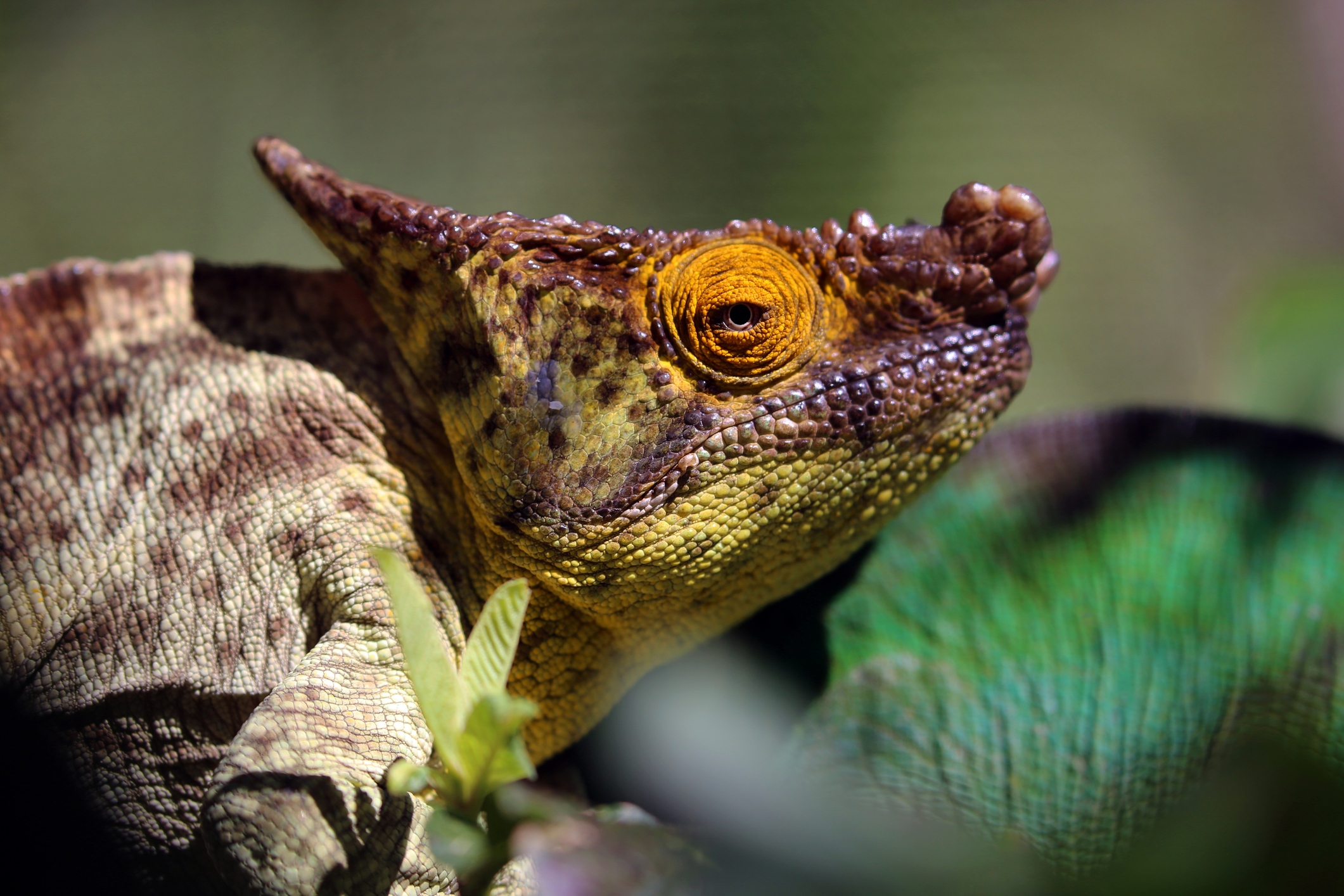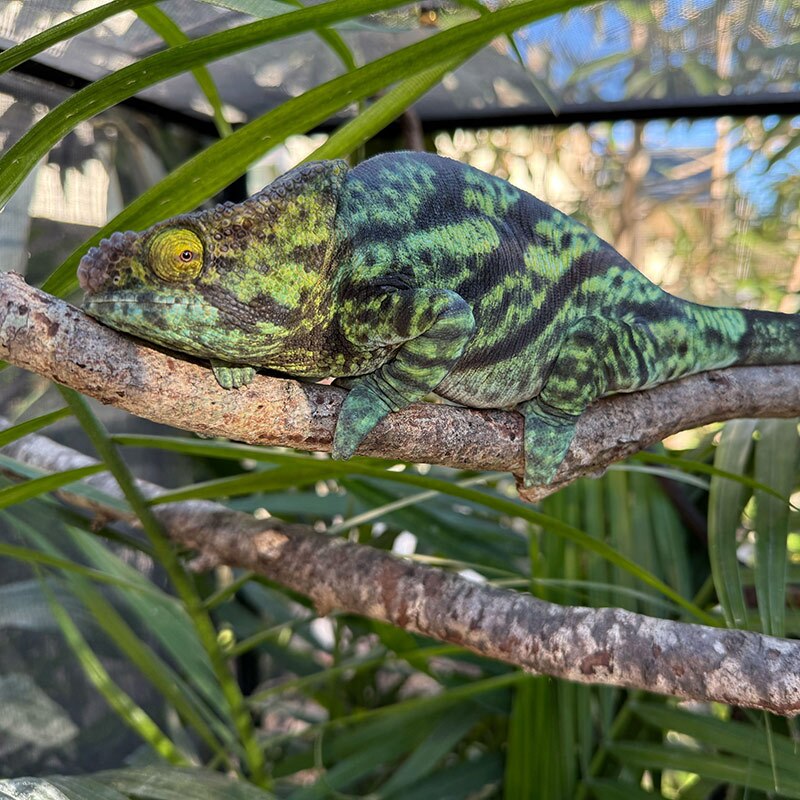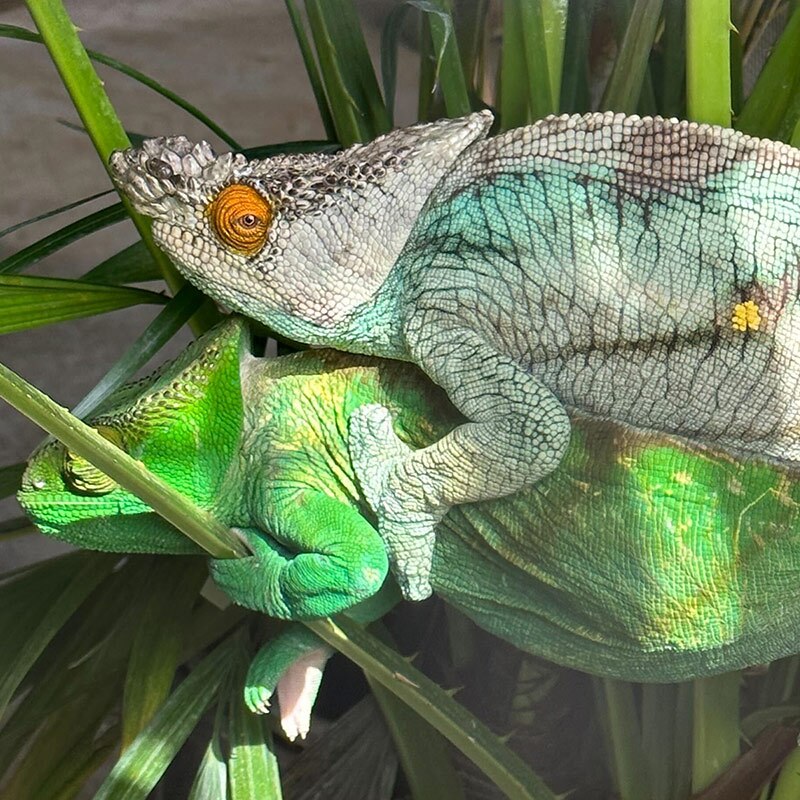
The Parson’s Chameleon (Calumma parsonii) is the largest and one of the most impressive chameleons in the world. Known for its size, striking appearance, and unique behaviors, this chameleon is a member of the Calumma genus, which includes several species of chameleons, all endemic to the island of Madagascar. The Parson’s Chameleon symbolizes Madagascar’s rich biodiversity and reminds us of the conservation challenges facing the island’s wildlife.
Here at Nealon Reptiles, we’ve been quietly building up to becoming one of the world’s premiere Parson’s Chameleon facilities. We still have work to do and knowledge to gain, but we’re well on our way.
To our knowledge, we are the only facility in the USA, and possibly the World, that keeps all 5 of the available Parson’s Chameleons, including Yellow Giants, Yellow Lips, Orange Eyes, Green Giants, and Cristifers.

Our male Green Giant Parson’s Chameleon, one of only two known in captivity
The World’s Largest Chameleons
The Parson’s Chameleon is the largest chameleon species in terms of overall body mass. Adult males can reach up to 27 inches (68 centimeters) in total length, including their tail, while females are generally smaller, reaching around 18-20 inches (45-50 centimeters). Parson’s Chameleons are also notable for their weight, with some individuals weighing as much as 700-800 grams (1.5-1.8 pounds). Our heaviest is a male Green Giant that weighed 886 grams in October of 2024. This considerable size makes them a standout among chameleons and contributes to their reputation as a “giant” in the reptile world.
Distribution and Habitat
Parson’s Chameleons are found exclusively in Madagascar, specifically in the island’s eastern rainforests. Their distribution ranges from lowland to montane forests, where they inhabit dense, humid environments. Common areas where they are found include the Andasibe-Mantadia National Park and the rainforests surrounding the Marojejy and Masoala National Parks.
These chameleons are arboreal, spending almost all of their time in the trees and rarely coming to the ground. Our females only come to the ground when they are laying eggs, and we never see our males on the ground. They prefer areas with thick canopy cover and plenty of foliage, which provides shelter, food, and camouflage from predators. The humid conditions of the rainforest are essential for their survival, as they require high moisture levels to maintain hydration and facilitate proper shedding.
Characteristics and Behavior
Parson’s Chameleons exhibit a variety of ‘color morphs’ (more than likely subspecies or locales), with males often displaying vibrant shades of green, turquoise, yellow, or even blue, depending on the region and subspecies. The two main subspecies, Calumma parsonii parsonii and Calumma parsonii cristifer, show different coloration and size variations. Females are usually not quite as colorful, but they are still beautiful in their own right. Female Parson’s Chameleons are almost always mostly green in coloration, with some individuals showing shades of blue or yellow. Both males and females will vary their coloration, intensity, and shades based on their mood or environmental stimuli, such as when they encounter each other.
Males possess prominent rostral ridges or nose-like protrusions, which give them a distinctive appearance. These ridges are less pronounced in females. These ridges are used in combat between males in the wild. In our collection, we’ve observed them using these ridges to seemingly funnel water toward their mouth. Whether or not they’re doing this on purpose of not is unknown.
Parson’s Chameleons are known for their slow and deliberate movements. They don’t do much of anything in a hurry. While our Panther Chameleons are quick to zero in on bugs we put into the enclosure, our Parson’s seem to always wait for the bug to come close. Even when hydrating our Parson’s Chameleons, they often take their sweet time to move into the mist – then drinking for what seems like forever.
Their zygodactylous feet (with toes fused into two groups for grasping) and prehensile tails enable them to easily navigate the branches. Their turret-like eyes can move independently, giving them a 360-degree field of view, essential for spotting prey and avoiding predators.

Perhaps the most commonly seen variation/locale/subspecies of Parson’s Chameleon is the Orange-Eyed Parson’s. Beautiful shades of green and sometimes blue contrast with the bright orange eye turrets.

Yellow-Lipped Parson’s Chameleons are unmistakable in appearance. Shades of green with yellow on the lips make males truly striking in appearance. We have numerous breeding pairs of Yellow-Lipped Parson’s Chameleons at our facility.

The rarest of the Parson’s Chameleons, the Green Giant is a amazing Chameleon. Here at Nealon Reptiles, we have one breeding pair of Green Giants, one of only two pairs in Captivity in the World.

The name ‘Yellow Giant’ is perfect for these chameleons. Not only are they various shades of yellow (and green sometimes), but they are also true giants! We have a number of breeding pairs and juveniles and babies in our facility.

In our opinion, the Cristifer Parson’s Chameleon is the perfect chameleon for most people. Much smaller than the giant subspecies, Parsonii cristifer stays a manageable size and have great personalities.
Conservation Status and Threats
The Parson’s Chameleon is currently listed as Near Threatened by the International Union for Conservation of Nature (IUCN). While not yet classified as endangered, the species faces several significant threats:
The primary threat to Parson’s Chameleons is habitat destruction due to deforestation. Madagascar’s rainforests are being cleared for agriculture, logging, and charcoal production, leading to the fragmentation of suitable habitats. This loss of forest cover significantly impacts their population, as they require specific environmental conditions to thrive. Because of this, captive Parson’s Chameleons should be used in breeding programs as often as possible. We feel that all keepers of Parson’s Chameleons should work towards establishing them in our care.
A second large factor is the illegal harvesting of animals for the pet trade. Although international trade is regulated under the Convention on International Trade in Endangered Species (CITES), illegal collection and export still occur, putting additional pressure on wild populations. These chameleons are highly sought after in the pet trade due to their size and striking appearance, which can incentivize poaching. The illegal pet trade should not be confused with the legal pet trade. Every year, Madagascar allows a limited number of Parson’s Chameleons to be exported. Their numbers are monitored to ensure that the impact on wild populations of Parson’s Chameleons is minimal to none. The problems start to happen when people take these Chameleons from protected habitats and/or in numbers that exceed the allowable numbers allowed by Madagascar.
Conservation Efforts
Efforts to protect the Parson’s Chameleon include habitat preservation, regulation of the pet trade, and captive breeding programs like the one here at Nealon Reptiles and other responsible breeders.
Conservation organizations and Malagasy authorities work to establish protected areas and enforce laws that limit habitat destruction and wildlife trafficking. Additionally, captive breeding programs have been established to help reduce the demand for wild-caught individuals and ensure sustainable populations exist in captivity. This is our ultimate goal when it comes to working with Parson’s Chameleons.


